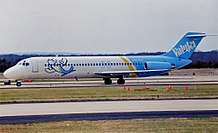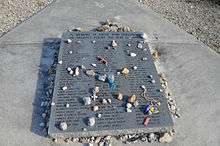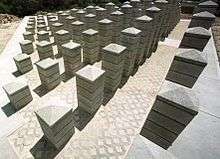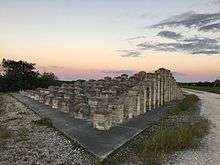ValuJet Flight 592
 N904VJ, the accident aircraft, seen here at Washington Dulles International Airport in May 1995 | |
| Accident | |
|---|---|
| Date | May 11, 1996 |
| Summary | In-flight fire leading to loss of control |
| Site |
Everglades, Miami-Dade County, Florida, United States 25°54′47″N 80°34′41″W / 25.91306°N 80.57806°WCoordinates: 25°54′47″N 80°34′41″W / 25.91306°N 80.57806°W |
| Aircraft | |
| Aircraft type | McDonnell Douglas DC-9-32 |
| Operator | ValuJet Airlines |
| Registration | N904VJ |
| Flight origin |
Miami International Airport Miami, Florida |
| Destination | William B. Hartsfield Atlanta Int'l Airport, Atlanta, Georgia |
| Passengers | 105 |
| Crew | 5 |
| Fatalities | 110 |
| Survivors | 0 |
ValuJet Flight 592 was a regularly scheduled flight from Miami International Airport to Hartsfield–Jackson Atlanta International Airport. On May 11, 1996, the ValuJet Airlines McDonnell Douglas DC-9 operating the route crashed into the Everglades about 10 minutes after taking off from Miami as a result of a fire in the cargo compartment caused by improperly stored cargo. All 110 people on board died.[1] The airline already had a poor safety record before the crash, and the accident brought widespread attention to the airline's problems. The airline was grounded for several months after the accident. When operations resumed, ValuJet had a decline in full fare passengers, leading ValuJet executives to believe that using the AirTran brand name for all airline operations was advantageous after the airline's holding company acquired AirTran Airways and its parent holding company.
Background
ValuJet Airlines was founded in 1992 and was known for its sometimes aggressive cost-cutting measures. Many of the airline's planes were purchased used from other airlines, little training was provided to workers, and contractors were used for maintenance and other services. The company quickly developed a reputation for its lax safety. In 1995, the U.S. military refused ValuJet's bid to fly military personnel because of safety worries, and officials at the FAA wanted the airline to be grounded.[2]
In 1986, an American Trans Air McDonnell Douglas DC-10 being serviced at Chicago's O'Hare International Airport had been destroyed on the ground by a fire caused by chemical oxygen generators.[3] In 1988, American Airlines Flight 132 (operated by a McDonnell Douglas MD-80) had a similar incident to that which later downed ValuJet Flight 592: a fire began in the cargo hold while the plane was in flight, caused by hazardous materials (primarily hydrogen peroxide), but in that case the crew landed the aircraft safely.[4]
After AA Flight 132, the National Transportation Safety Board (NTSB) recommended to the FAA that all class D cargo holds have smoke detectors and fire suppression systems.[4]
Aircraft and crew
The aircraft was a DC-9-32,[5] it was 27 years old at the time and had been previously flown by Delta Air Lines. Its first flight was April 18, 1969. Delivered to Delta on May 27, 1969, the airframe flew for Delta until the end of 1992, when it was retired and sold back to McDonnell Douglas. McDonnell Douglas then sold the plane to ValuJet in 1993.
The aircraft had suffered a series of incidents in the two years before the crash, including aborted takeoffs and emergency landings.[6]
In the flight deck were two experienced pilots: Captain Candi Kubeck (35) and First Officer Richard Hazen (52). Captain Kubeck had accumulated over 9,000 hours throughout her career and First Officer Hazen had more than 11,800 total flight hours throughout his career.[7]
Accident
On the afternoon of May 11, 1996, Flight 592 pushed back from gate G2 in Miami after a delay of 1 hour and 4 minutes due to mechanical problems.[1] There were 105 passengers, mainly from Florida and Georgia, on board, as well as a crew of two pilots and three flight attendants, bringing the total number of people on board to 110. At 14:04, 10 minutes before the disaster, the DC-9 took off from runway 9L (now runway 8R) and began a normal climb.
At 14:10, the passengers started to smell smoke. At the same time, the pilots heard a loud bang in their headphones and noticed the plane was losing electrical power. The sag in electrical power and the bang were eventually determined to be the result of a tire in the cargo hold exploding. Seconds later, a flight attendant entered the cockpit and informed the flight crew of a fire in the passenger cabin. Passengers' shouts of "fire, fire, fire" were recorded on the cockpit voice recorder when the cockpit door was opened. Though ValuJet's flight attendant training manual stated that the cockpit door should not be opened when smoke or other harmful gases might be present in the cabin, the intercom was not functional and informing the pilots of what was happening was difficult. The flight data recorder indicated a progressive failure of the DC-9's electrical and flight control systems due to the spreading fire.
Kubeck and Hazen immediately asked air traffic control for a return to Miami due to the increasing smoke in the cockpit and cabin, and were given instructions for a return to the airport. One minute later, Hazen requested the nearest available airport. Kubeck began to turn the plane left in preparation for the return to Miami.
Flight 592 disappeared from radar at 14:13:42. Eyewitnesses nearby watched as the plane banked sharply, rolled onto its side and nosedived into the Francis S. Taylor Wildlife Management Area in the Everglades, a few miles west of Miami, at a speed in excess of 507 miles per hour (816 km/h). Kubeck lost control of the plane less than 10 seconds before impact. Examination of debris suggested that the fire had burned through the floorboards in the cabin, resulting in structural failure and damage to cables underneath the instrument panels. The NTSB report on the accident stated, "the Safety Board cannot rule out the possibility that the flightcrew was incapacitated by smoke or heat in the cockpit during the last 7 seconds of the flight."[8]:107 Interruptions in the cockpit voice recorder occurred on two occasions, one as long as 1 minute 12 seconds.[8]:174 The aircraft hit the water at 14:13:42 Eastern Daylight Time, about 10 minutes after takeoff. The impact site was on the western edge of Florida Water Conservation Area 3B, between two levees, in an area known as the L-67 Pocket.[9]
None of the 110 passengers or crew on board survived the accident. Additionally, recovery of the aircraft and victims was made extremely difficult by the location of the crash. The nearest road of any kind was more than a quarter mile (400 m) away from the crash scene, and the location of the crash itself was a deep-water swamp with a floor of solid limestone. The aircraft was destroyed on impact, with no large pieces of the fuselage remaining. Sawgrass, alligators, and risk of bacterial infection from cuts plagued searchers involved in the recovery effort.
According to the NTSB's report, two witnesses fishing nearby testified "that they saw a low-flying airplane in a steep right bank. According to these witnesses, as the right bank angle increased, the nose of the airplane dropped and continued downward. The airplane struck the ground in a nearly vertical attitude."[8]:4
They reported seeing no external damage or any sign of fire or smoke other than the engine exhaust. A group of sightseers in a small private plane also witnessed the crash and provided a nearly identical account, stating that Flight 592 seemed to "disappear" after hitting the swamp and they could see nothing but scattered small debris and part of an engine near the crash site.
Victims
| Residencies[10] | Passengers | Crew | Total |
|---|---|---|---|
| 99 | 5 | 104 | |
| 2 | - | 2 | |
| 2 | - | 2 | |
| Unspecified | 2 | - | 2 |
| Total | 105 | 5 | 110 |

Notable passengers killed on the flight included:[10]
- San Diego Chargers running back Rodney Culver and his wife Karen
- Songwriter and musician Walter Hyatt
Recovery of the passengers and crew took several weeks and little in the way of intact human remains was found due to the sheer violence of the impact, immersion in swamp water, and scavenging wildlife. About 68 of the 110 persons aboard the plane were identified, in some cases from examining jawbones, and at least one individual from a single tooth. A piece of torn flesh was proven to belong to First Officer Hazen, but Captain Kubeck's remains were never found. Due to the above-mentioned factors, performing toxicology tests on the passenger and crew remains to determine how much exposure they would have had to fumes and smoke from the in-flight fire was not possible.
Investigation
At the end of a fifteen-month investigation, the NTSB determined that the fire that downed Flight 592 developed in a cargo compartment below the passenger cabin.[1] The cargo compartment was a Class D design, in which fire suppression is accomplished by sealing off the hold from outside air. Any fire in such an airtight compartment would quickly exhaust all available oxidizers and then burn itself out. As the fire suppression can be accomplished without any intervention by the crew, such holds are not equipped with smoke detectors. However, the NTSB quickly determined that just before takeoff, over 100[11] expired chemical oxygen generators, each slightly larger than the size of a tennis ball can, had been placed in the cargo compartment in five boxes marked COMAT (company material) by ValuJet's maintenance contractor, SabreTech, in violation of FAA regulations forbidding the transport of hazardous materials in passenger aircraft cargo holds. Failure to cover the generators' firing pins with the prescribed plastic caps made an accidental activation much more likely. The investigation revealed that rather than covering them, the cords attached to the firing pins were simply cut or duct-taped around the cans, and Scotch tape was also used to stick the ends down. SabreTech employees indicated on the cargo manifest that the "oxy canisters", which were loosely packed in the boxes that were each sealed with tape and bubble wrap, were "empty". ValuJet workers then loaded the boxes in the cargo hold in the mistaken belief that the devices that they contained were just empty canisters, thus being certified as supposedly "safe" to transport on a passenger aircraft, when in fact they were neither simple oxygen canisters, nor empty.[12]
Chemical oxygen generators, when activated, produce oxygen for passengers if the plane suffers a decompression. However, they also produce a great quantity of heat due to the exothermic nature of the chemical reaction involved. Therefore, not only could the heat and generated oxygen start a fire, but the oxygen could also keep the fire burning. The fire was worsened by the presence of two main aircraft tires (one of them mounted on a main wheel) and a nose tire and wheel that were also included in the list of materials shipped as COMAT. Investigators determined that when the plane experienced a slight jolt while taxiing, one of the oxygen generators was triggered. Over time through taxiing and takeoff, the activated generator got hotter and hotter. Soon, the boxes and surrounding packaging ignited, starting a fire.
Laboratory testing showed that canisters of the same type could heat nearby materials up to 500 °F (260 °C). The oxygen from the generators fed the resulting fire in the cargo hold without any need for outside air, defeating the cargo hold's airtight design. A pop and jolt heard on the cockpit voice recording and correlated with a brief and dramatic spike in the altimeter reading in the flight data recording were attributed to the sudden cabin pressure change caused by one of the wheels in the cargo hold exploding due to the heat.[12] Investigators also determined that in this process, the fire began to destroy control cables that ran to the back of the aircraft, which explained why the pilots began losing control before the plane crashed.
Smoke detectors in the cargo holds can alert the flight crew of a fire long before the problem becomes apparent in the cabin, and a fire suppression system buys valuable time to land the plane safely. In February 1998, the FAA issued revised standards requiring all Class D cargo holds to be converted by early 2001 to Class C or E; these types of holds have additional fire detection and suppression equipment.[12][13]
Culpability
The NTSB report placed responsibility for the accident on three parties:
- SabreTech, for improperly packaging and storing hazardous materials
- ValuJet, for not supervising SabreTech
- FAA, for not mandating smoke detection and fire suppression systems in cargo holds as recommended in 1988 after a similar incident
In 1997, a federal grand jury indicted SabreTech for mishandling hazardous materials, failing to train its employees in proper handling of hazardous materials, conspiracy, and making false statements. SabreTech's maintenance supervisor, Daniel Gonzalez, and two mechanics who worked on the plane, Eugene Florence and Mauro Valenzuela, were charged with conspiracy and making false statements. Two years later, having been found guilty on the mishandling hazardous materials and improper training charges, SabreTech was fined $2 million and ordered to pay $9 million in restitution. Gonzalez and Florence were acquitted on all charges, while Valenzuela failed to appear and was indicted in absentia for contempt of court.[14] Valenzuela is still a fugitive; he was specifically highlighted in the EPA's announcement of a website to search for "environmental fugitives."[15] The FBI has offered a $10,000 reward for information on his whereabouts. [16]
In 2001, the United States 11th Circuit Court of Appeals reversed SabreTech's guilty verdict in part. In so doing, the panel concluded that federal law at the time of the crash could not support a conviction for mishandling hazardous materials and that the government did not prove that SabreTech intended to cause harm. The panel did, however, uphold the conviction for improper training, and on remand, the District Court sentenced SabreTech to a $500,000 fine, three years' probation, and no restitution.
Just before the federal trial, a Florida grand jury indicted SabreTech on 110 counts of manslaughter and another 110 counts of third-degree murder: one for each person who died in the crash. SabreTech settled the state charges by agreeing to plead no contest to a state charge of mishandling hazardous waste and to donate $500,000 to an aviation safety group and a Miami-Dade County charity.
SabreTech was the first American aviation company to be criminally prosecuted and convicted for its role in an American airline crash. The company, a subsidiary of St. Louis-based Sabreliner Corporation, went out of business in 1999, but Saberliner Corporation is still operating.
ValuJet was grounded by the FAA on June 16, 1996, and was allowed to resume flying again on September 30, but never recovered from the crash.[17] In 1997, the company acquired AirTran Airways. Although ValuJet was the nominal survivor, the ValuJet executives believed that a new name was important to regain passenger traffic. In 2006, AirTran did not make any major announcements on the crash's 10th anniversary out of respect for the victims' families.[18]
Many families of Flight 592's victims were outraged that ValuJet was not prosecuted, given the airline's poor safety record. ValuJet's accident rate was not only one of the highest in the low-fare sector, but also 14 times higher than those of legacy airlines. In the aftermath of the crash, an internal FAA memo surfaced questioning whether ValuJet should have been allowed to stay in the air.[6] The victims' families also point to statements made by ValuJet's officials immediately after the crash which led many to believe that ValuJet knew the generators were on the plane, and had ordered them returned to Atlanta rather than properly disposed of in Miami.[19]
Legacy

On the third anniversary of the accident, in 1999, a memorial was dedicated to the victims in the Everglades. The memorial, consisting of 110 concrete pillars, is located just north of Tamiami Trail at 25°45′42.61″N 80°40′19.30″W / 25.7618361°N 80.6720278°W, about 11.9 miles west of Krome Avenue in Miami-Dade County and points to the location of the crash site 11.9 miles to the north-northeast. Students from the American Institute of Architecture designed the memorial, and local contractors, masons, and labor unions built it for free.[20]

In a June 4, 2013, Miami Herald article, a local resident stated that while slogging through the sawgrass several months earlier, he found a partially melted gold pendant in the same area, which is thought possibly to be from either the ValuJet crash or the crash of Eastern Air Lines Flight 401, which had occurred about 2 miles (3.2 km) from the ValuJet crash site.[21]
After the crash, ValuJet stopped using 592 as a flight number. Following their merger with AirTran in which AirTran was the surviving airline, Flight 592 was retired from AirTran's flight numbers as well. As of January 5, 2015, shortly after their full subsumption of AirTran, Southwest Airlines also withdrew the further use of 592 in the Southwest system as a flight identifier.[22]
In popular culture
COPS happened to be taping with the Miami-Dade Police Department when the accident occurred. As a result, season 9, episode 12, aired featuring some of the first 911 calls and the initial investigations into the accident. Three National Geographic shows, Why Planes Crash ("Fire In The Sky"), Seconds From Disaster ("Florida Swamp Air Crash"), and Mayday ("Fire in the Hold"),[12] covered the crash. It was also featured in the last episode of the four-part Travel Channel series Probable Cause: Air Crash Investigations (Acceptable Risk). It was also referenced in the first CSI: Miami episode ("Golden Parachute") in 2002, as well as a second-season episode ("Wannabe") in 2004. The 2009 Law & Order episode ("By Perjury") was also based on the case.
See also
- Air Canada Flight 797
- Asiana Airlines Flight 991
- Eastern Air Lines Flight 401 – a 1972 accident in which a Lockheed L-1011 TriStar crashed into the Florida Everglades not far from where Flight 592 crashed
- List of accidents and incidents involving commercial aircraft
- Nigeria Airways Flight 2120 – a crash resulting from an in-flight fire triggered by a flat tire
- Northwest Airlines Flight 705 – another airliner that crashed in the Everglades in February 1963
- Saudia Flight 163
- South African Airways Flight 295 – a crash resulting from an unknown cause which triggered an in-flight fire in the cargo hold
- Swissair Flight 111 – a 1998 crash of a McDonnell Douglas MD-11, in which faulty wiring triggered an in-flight fire
- UPS Airlines Flight 6 – a crash resulting from an in-flight fire caused by burning lithium-ion batteries in the cargo hold
- Varig Flight 820
References
- 1 2 3 ""NTSB Report AAR97-06"" (PDF). Retrieved 22 July 2017.
- ↑ Matthews, Rick A.; Kauzlarich, David (1 August 2000). "The Crash of Valujet Flight 592: A Case Study in State-Corporate Crime". Sociological Focus. 33 (3): 281–298. doi:10.1080/00380237.2000.10571171. ISSN 0038-0237.
- ↑ Ranter, Harro. "ASN Aircraft accident McDonnell Douglas DC-10-40 N184AT Chicago-O'Hare International Airport, IL (ORD)". aviation-safety.net. Retrieved 22 July 2017.
- 1 2 "Safety Recommendation A-88-123". National Transportation Safety Board. National Transportation Safety Board. Retrieved 23 January 2016.
- ↑ "Aviation Photo #0029996: McDonnell Douglas DC-9-32 - Valujet". Airliners.net. Retrieved 22 July 2017.
- 1 2 Lawrence, Neal (Autumn 1998). "Danger in the Skies". Midwest Today.
- ↑ http://www.ntsb.gov/doclib/reports/1997/aar9706.pdf
- 1 2 3 NTSB. "Aircraft Accident Report In-Flight Fire and Impact with Terrain Valujet Airlines Flight 592" (PDF). National Transportation Safety Board Public Inquiries Section, RE-51 490 L’Enfant Plaza, S.W. Washington, DC 20594: National Transportation Safety Board. Retrieved 24 January 2016.
- ↑ Davis, Steve; Ogden, John C. (1994-01-01). Everglades: The Ecosystem and Its Restoration. CRC Press. ISBN 9780963403025.
- 1 2 "Complete list of passengers and crew." CNN. Retrieved on December 23, 2008.
- ↑ "Indicted in 1996 ValuJet Crash, Airline Mechanic Still on EPA's Most-Wanted List". New York Times. Retrieved 24 January 2016.
- 1 2 3 4 Mayday, "Fire in the Hold", season 12 episode 2
- ↑ "Revised Standards for Cargo or Baggage Compartments in Transport Category Airplanes". Federal Register. 17 February 1998. Retrieved 2008-10-23.
- ↑ "Mechanic in SabreTech Case Indicted for Contempt of Court". USDOT. October 13, 1999. Archived from the original on September 17, 2008.
- ↑ "12/10/2008: Wanted: Environmental Fugitives/ Federal government launches first-ever environmental crimes fugitive web site". Environmental Protection Agency. Retrieved 2010-02-10.
- ↑ "ValuJet Flight 592 crash: FBI offers $10,000 for info on fugitive in deadly 1996 crash". Retrieved 2018-04-06.
- ↑ Fishman, Donald A. (1 September 1999). "ValuJet flight 592: Crisis Communication Theory Blended and Extended". Communication Quarterly. 47 (4): 345–375. doi:10.1080/01463379909385567. ISSN 0146-3373.
- ↑ Huettel, Steve (May 11, 2006). "10 years after tragedy, AirTran flies on". St. Petersburg Times. Archived from the original on October 12, 2012.
- ↑ "US Attorneys' Office Ignores Critical Evidence in the Valujet Crash: Valujet admitted oxygen generators were to be returned". flight592.com. July 12, 1999. Archived from the original on January 13, 2007.
- ↑ "Crash Memorial Moving, Welcome". Retrieved 22 July 2017.
- ↑ Herrera, Chabeli (2013-06-04). "Gold pendant found at site of Everglades plane crashes". Miami Herald. Retrieved 2013-10-01.
- ↑ "Southwest (WN) #592 ✈ FlightAware". FlightAware. Retrieved 16 April 2018.
Further reading
- Langewiesche, William (March 1, 1998). "The Lessons of Valujet 592". The Atlantic. – Langewiesche presents a case that the ValuJet crash is an example of a "system accident," including the overly formal labeling and safety information on the oxygen 'canisters' (which actually were oxygen generators).
- Larson, Eric (May 20, 1996). "Death in the Everglades". TIME. (Subscription required for access to full article.)
- Flight 592 special report (CNN)
- NTSB brief report
- NTSB full report (PDF)
- Valenzuela's post on US EPA's Fugitive Site
- Audio transcript of the Air Traffic Control conversations
- "Valujet: The Crash of Flight 592 – The Accident". CNN. 1997. Archived from the original on August 16, 2000.
- Tester, Hank. "ValuJet Crash Remembered 15 Years Later" (Archive). NBC Miami. Wednesday May 11, 2011.
- "Valujet 592's Last Flight". The New York Times. November 19, 1996. – Transcript of the Valujet 592 flight recorder.
- Memorial location on Google Maps
- ValuJet Flight 592 Memorial
External links
- Bragg, Rick (December 7, 1999). "Contractor Found Guilty in Trial on ValuJet Crash". The New York Times.
- Reed, Dan; Jones, Charisse (September 28, 2010). "Low-fare king Southwest to buy AirTran for $1.4 billion". USA Today.
- Photo of the plane after being retired by Delta and bought by Valujet
- Photo of the plane while in service with Valujet
- "Passenger list and gallery". flight592.com. Archived from the original on June 14, 2007.